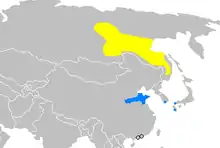Hooded crane
The hooded crane (Grus monacha) is a small, dark crane. It has a grey body. The top of the neck and head is white, except for a patch of bare red skin above the eye. It is one of the smallest cranes, but is still a fairly large bird, at 1 m (3.3 ft) long, a weight of 3.7 kg (8.2 lbs) and a wingspan of 1.87 m (6.2 ft).
| Hooded crane | |
|---|---|
 | |
| Wintering in Kyushu, Japan | |
| Scientific classification | |
| Kingdom: | Animalia |
| Phylum: | Chordata |
| Class: | Aves |
| Order: | Gruiformes |
| Family: | Gruidae |
| Genus: | Grus |
| Species: | G. monacha |
| Binomial name | |
| Grus monacha Temminck, 1835 | |
 | |
| Hooded crane distribution Yellow : breeding range Blue : wintering range | |
The hooded crane breeds in south-central and south-eastern Siberia. Breeding is also suspected to occur in Mongolia. Over 80% of its population winters at Izumi, southern Japan. There are also wintering grounds in South Korea and China. There are about 100 hooded cranes wintering in Chongming Dongtan, Shanghai every year. Dongtan Nature Reserve is the largest natural wintering site in the world. In December 2011, a hooded crane was seen overwintering at the Hiwassee Refuge in southeastern Tennessee, well outside its normal range.[2] In February 2012, one was seen at Goose Pond in southern Indiana, and is suspected to be the same bird, which may have migrated to North America by following sandhill cranes.[3] In April, 2020 one was shot by local hunters in Malakand, Pakistan. It was accepted as a valid record as the first confirmed specimen for the Indian Subcontinent.
The estimated population of the species is 11,600 individuals.[4] The major threats to its survival are wetland loss and degradation in its wintering grounds in China and South Korea as a result of reclamation for development and dam building. Conservation activities have been taken since 2008. Local universities, NGOs and communities are working together for a better and safer wintering location.
The hooded crane is evaluated as Vulnerable on the IUCN Red List of Threatened Species.[1] It is listed on Appendix I and II of CITES. A society, Grus monacha International Aid (白头鹤的故事), has been formed to find ways to protect the species.[5]
References
- BirdLife International 2016. Grus monacha. The IUCN Red List of Threatened Species 2016: e.T22692151A93337861. https://dx.doi.org/10.2305/IUCN.UK.2016-3.RLTS.T22692151A93337861.en. Downloaded on 22 April 2020.
- Reuters. Rare Asian bird takes "wrong turn," lands in Tennessee
- http://www.birdlife.org/datazone/speciesfactsheet.php?id=2795
- Grus monacha International Aid
External links
| Wikimedia Commons has media related to Grus monacha. |
- BirdLife Species Factsheet
- Hooded Crane (Grus monachus) from Cranes of the World (1983) by Paul Johnsgard
